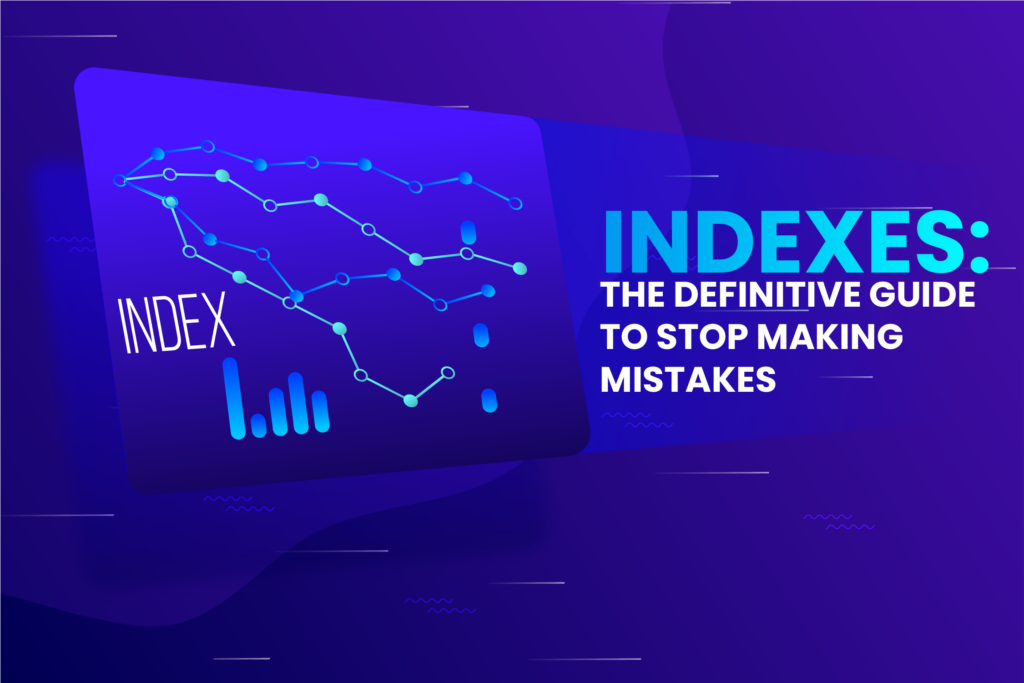

Creating an index is, in isolation, the highest-impact optimization an engineer can apply to a database. A single successful CREATE INDEX statement can reduce a query’s latency from minutes to milliseconds, lower CPU load from 90% to 1%, and postpone the need for an expensive hardware upgrade for months or even years. However, this same apparent simplicity hides a complexity that leads to chronic and widespread errors. Reactive indexing, based on assumptions or applied without a clear strategy, often worsens performance problems instead of solving them.
The result is an environment with “index sprawl,” where writes become slow, the query planner gets confused, and the maintenance cost outweighs the read benefits. This definitive guide technically details the most common errors in indexing strategy and presents the correct, data-driven approach to transform your indexes from a maintenance liability into your most valuable performance asset.
Error 1: Indexing Without a Strategy (Over-Indexing and Under-Indexing)
The most fundamental error is treating indexing as a purely reactive task and not as a central component of the data architecture. This manifests in two equally harmful extremes: the lack of essential indexes (under-indexing) and the excessive creation of useless or redundant indexes (over-indexing).
The Problem of Under-Indexing
This is the most obvious form of error: the absence of an index on a column frequently used in WHERE, JOIN, or ORDER BY clauses. Without the index, the database is forced to perform a Full Table Scan, an inefficient operation where it reads every row of the table to find the requested data. On small tables, the impact is negligible. On tables with millions or billions of records, it is a death sentence for performance. The symptom is clear: queries that were fast become progressively slower as the data grows, and CPU and I/O utilization skyrockets.
The Problem of Over-Indexing (Index Sprawl)
This is the more subtle and dangerous error. In an attempt to solve read problems, teams create indexes for every column they think might be queried. The result is a proliferation of indexes. What many don’t realize is that indexes are not free.
- Storage Cost: Each index is a separate data structure that consumes disk space, sometimes as much as the table itself.
- Write Operation Penalty: This is the highest cost. For every INSERT, UPDATE, or DELETE on a table, the database must update not only the table but also each of its indexes. If a table has 10 indexes, a single row insertion turns into 11 write operations on the disk. This can drastically degrade the performance of transactional workloads, causing lock contention and slowness in critical operations.
- Complexity for the Optimizer: With many redundant or overlapping indexes, the query planner has more work to do to choose the best index for a given query. In some cases, it might make a suboptimal choice, resulting in a less efficient execution plan than expected.
“Index sprawl” is a technical debt that accumulates silently. dbsnOOp is fundamental to combating both problems, as its workload analysis identifies both the queries that need an index (combating under-indexing) and the indexes that are never used (combating over-indexing), providing a clear view to clean up and optimize the indexing strategy.
Error 2: Ignoring Column Order and Cardinality
Creating a multi-column (composite) index is not just a matter of listing the columns. The order in which they are declared is the most critical factor for its effectiveness. The general rule is to place the most selective column, the one with the highest cardinality, first.
What is Cardinality?
Cardinality refers to the number of distinct values in a column. An id column (primary key) has the maximum cardinality (each value is unique). A status column with values like ‘active’, ‘inactive’, ‘pending’ has a very low cardinality (only 3 distinct values).
The Impact of Column Order
Consider a tasks table with the columns account_id (high cardinality, many different values) and status (low cardinality, few values). We have a common query:
SELECT * FROM tasks WHERE account_id = 123 AND status = 'completed';
Let’s analyze two indexing strategies:
- Incorrect Index: CREATE INDEX idx_wrong ON tasks(status, account_id);
- How it works: The database first filters by status. It might find millions of tasks with the status ‘completed’. Within this huge subset, it then looks for account_id 123. Most of the filtering work is done in the second step, making the index inefficient.
- Correct Index: CREATE INDEX idx_correct ON tasks(account_id, status);
- How it works: The database first filters by account_id. Since the cardinality is high, it quickly locates the small set of tasks belonging to account 123. Within this already reduced set, it finds the ones with the status ‘completed’. The most powerful filtering occurs in the first step, making the index extremely efficient.
The correct index can be hundreds of times faster than the incorrect one. Making this decision based on assumptions is risky. The correct approach is to analyze the workload with a tool like dbsnOOp, which recommends the creation of indexes based on the actual queries and their WHERE clauses, ensuring that the column order is optimized for the production access patterns.

Error 3: Using the Wrong Type of Index for the Job
The default CREATE INDEX statement in most databases (like PostgreSQL and MySQL) creates a B-Tree index. While it is versatile and efficient for most use cases, it is not the solution for every problem. Using the wrong type of index can result in suboptimal performance or the inability to accelerate certain types of queries.
- B-Tree: This is the de facto standard. It stores data in an ordered fashion, which makes it extremely efficient for exact value lookups (=), range lookups (<, >, BETWEEN), and sorting (ORDER BY). It is the workhorse of indexing.
- Hash: Available in some databases, like PostgreSQL. It is optimized only for equality comparisons (=). It can be marginally faster than a B-Tree for this specific use case but cannot be used for range lookups. Its use is more restricted.
- GIN (Generalized Inverted Index): Specific to PostgreSQL, it is designed to index composite values, such as the elements of an array, the lexemes of a text document (for full-text search), or the key-value pairs of a JSONB. Trying to use a B-Tree to search within a JSONB field would be extremely inefficient; a GIN index is the correct tool and can speed up the query by orders of magnitude.
- GiST (Generalized Search Tree): Also from PostgreSQL, it is a framework that allows the indexing of more complex data types, being the basis for geospatial indexing (PostGIS), which enables efficient queries like “find all points within this polygon.”
Choosing the right type of index requires a deeper understanding of both your data and your query patterns. An observability platform doesn’t choose the index type for you, but by precisely identifying which query is slow and what type of data it operates on, it provides the engineer with the exact context needed to make the correct and informed decision.
Error 4: Neglecting Index Maintenance
Indexes are not static structures. They live and degrade over time, especially in environments with a high rate of write operations (INSERT, UPDATE, DELETE). Neglecting their maintenance is a silent error that gradually erodes performance.
Index Fragmentation
When rows are inserted, updated, and deleted, the indexes need to be constantly reorganized. Over time, this can lead to fragmentation. Index blocks that were once contiguous become scattered across the disk, and index “pages” can become partially empty. The result is that the index becomes larger than necessary and requires more I/O operations to be read, making it slower. In databases like PostgreSQL and SQL Server, REINDEX or REORGANIZE operations are necessary to rebuild the index optimally and remove fragmentation.
Stale Statistics
This is perhaps the most critical maintenance problem. The query planner (the “brain” of the database) depends on statistical metadata about the distribution of data in the tables to make intelligent decisions about which index to use. These statistics include information like the number of rows, the most common values, and the cardinality of the columns.
If a table undergoes many insertions and deletions, these statistics can become outdated. The planner, operating with incorrect data, might start making bad decisions, such as choosing a Full Table Scan even when a good index exists, because it calculates that this would be the cheaper option based on the old statistics. Operations like ANALYZE (PostgreSQL) or UPDATE STATISTICS (SQL Server) are crucial to keep the planner well-informed.
dbsnOOp helps to identify these problems indirectly. If the platform detects that the performance of a well-indexed query has started to degrade over time, or if the planner has suddenly switched to a bad execution plan, this is a strong indicator that the statistics may be outdated, signaling the need for a maintenance action.
The Correct Approach: Workload-Driven Indexing
The conclusion from all these points is that effective indexing cannot be based on assumptions, rules of thumb, or reactive manual analysis. The only source of truth for an indexing strategy is your production workload. You don’t index tables; you index queries.
This is where an observability platform like dbsnOOp becomes indispensable, transforming indexing from a dark art into a data-driven science.
- Opportunity Identification: dbsnOOp continuously monitors 100% of the queries in production. Its ranking of “Top SQL” by resource consumption (DB Time) instantly reveals which queries are the biggest bottlenecks and, therefore, the main candidates for optimization via indexing.
- Root Cause Analysis: For each slow query, dbsnOOp captures and analyzes the execution plan. It automatically diagnoses the root cause, whether it’s a Full Table Scan, an inefficient Nested Loop, or any other costly operation.
- Precise and Actionable Recommendations: This is the transformative step. Based on the analysis, dbsnOOp generates the exact CREATE INDEX command needed to solve the problem. The recommendation already takes into account the correct columns in the correct order, based on the actual query’s clauses, eliminating human error and guesswork.
- Combating Index Sprawl: dbsnOOp can also identify indexes that are not being used by any query in your workload. These indexes are just “dead weight” that penalize your write operations. The platform provides a clear list of these indexes, allowing the team to safely remove them, improving the performance of INSERTs and UPDATEs.
From Guesswork to Precision Engineering
An effective indexing strategy is the pillar of a database’s performance. The common errors, over-indexing or under-indexing, getting the column order wrong, or neglecting maintenance, can turn this pillar into a bottleneck.
The solution is to stop guessing. By adopting a workload-driven approach, using an observability platform to analyze the actual queries and their costs, engineering teams can transform their indexing strategy into a practice of precision engineering. The result is a faster, more stable, and cheaper system to operate, where every index exists for a clear and measurable reason: to accelerate your business.
Want to eliminate the errors in your indexing strategy? Schedule a meeting with our specialist or watch a live demo!
To schedule a conversation with one of our specialists, visit our website. If you prefer to see the tool in action, watch a free demo. Stay up to date with our tips and news by following our YouTube channel and our LinkedIn page.
Schedule a demo here.
Learn more about dbsnOOp!
Learn about database monitoring with advanced tools here.
Visit our YouTube channel to learn about the platform and watch tutorials.

Recommended Reading
- The report that has already saved millions for companies like yours: This article technically details how workload diagnosis translates into a massive ROI, connecting query optimization to the direct reduction of cloud costs, the decrease in engineering time spent on troubleshooting, and the recovery of revenue lost to latency.
- Why relying only on monitoring is risky without a technical assessment: Explore the critical difference between passive monitoring, which only observes symptoms, and a deep technical assessment, which investigates the root cause of problems. The text addresses the risks of operating with a false sense of security based solely on monitoring dashboards.
- Your database might be sick (and you haven’t even noticed): Discover the signs of chronic and silent problems that don’t trigger obvious alerts but that degrade performance and stability over time. The article focuses on the need for diagnostics that go beyond superficial metrics to find the true health of your data environment.

